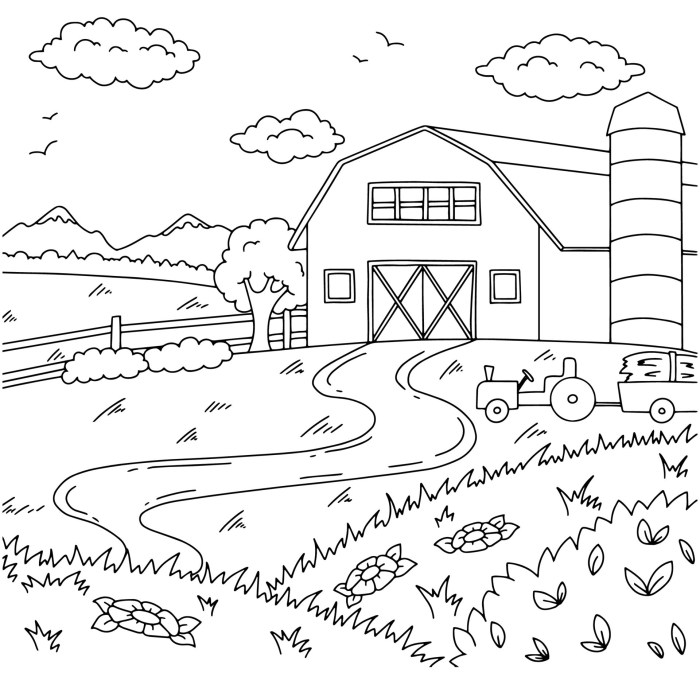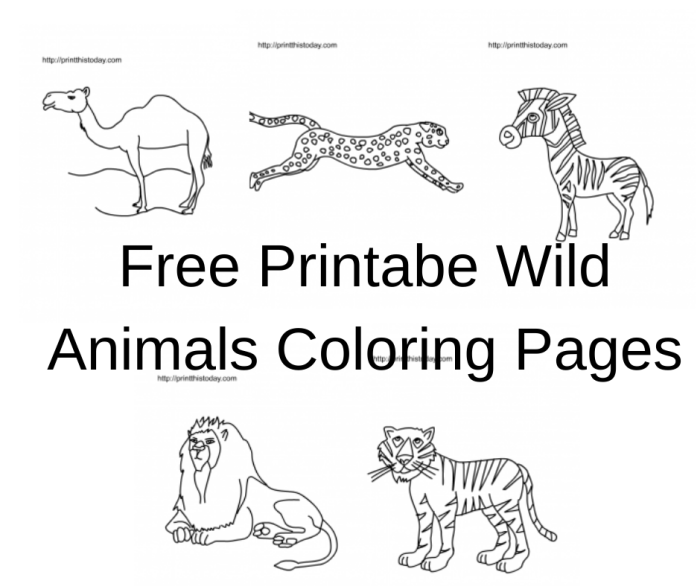Illustrations and Visual Style

Farm coloring book pages – The visual style of this farm coloring book will cultivate a sense of charming simplicity, appealing to both children and adults. The aesthetic will prioritize clarity and encourage creative expression, rather than overwhelming detail. A consistent visual language will be established throughout, creating a cohesive and enjoyable coloring experience.
The illustrations will employ a combination of techniques to achieve the desired effect. Simple line art will form the foundation, providing clean Artikels and easy-to-follow shapes. These lines will be deliberately uncluttered, allowing ample space for the user’s color choices to shine. In some instances, subtle shading or textural elements will be added using a delicate watercolor wash effect, lending depth without sacrificing the clean lines.
This combination of techniques creates a visual balance between simplicity and engaging detail.
Color Palette
The color palette will be vibrant yet naturalistic, reflecting the beauty of a sun-drenched farm. Earthy tones such as warm browns, greens, and yellows will dominate, representing the fields, barns, and animals. Accents of brighter colors, like reds and blues, will be incorporated strategically to highlight key elements and add visual interest. The palette will avoid overly saturated or harsh colors, maintaining a gentle and inviting atmosphere.
For example, a deep ochre for the sun-baked soil, a soft sage green for the pasture, and a rich burnt sienna for the barn wood will be key components. Brighter blues will be reserved for the clear sky, and pops of red for farm trucks or a farmer’s overalls.
Line Weight and Style
Line weight will be consistent throughout the illustrations, using a medium-weight line that is both visible and easy to color within. The lines will be smooth and even, avoiding harsh strokes or jagged edges. This consistent line weight creates a sense of unity and professionalism, contributing to the overall aesthetic appeal. The style will be slightly rounded, avoiding sharp angles, which softens the overall look and makes the illustrations more approachable for younger children.
Cover Design Options
Three distinct cover designs are proposed, each aiming to capture the essence of the farm theme while showcasing a unique visual style.
The first cover features a whimsical illustration of a friendly farm animal, perhaps a smiling pig or a playful lamb, set against a backdrop of a simplified barn and rolling hills. The typography will be playful and childlike, using a bold, rounded font for the title “Farm Fun Coloring Book.” This design is bright and cheerful, immediately appealing to young children.
The second cover showcases a more realistic depiction of a farm scene. A detailed but not overly complex illustration of a field of sunflowers, a red barn, and a few grazing cows will be the focal point. The typography will be clean and elegant, using a slightly more mature font, perhaps a serif font, for the title “My Farm Coloring Book.” This design appeals to a slightly older audience, while maintaining a welcoming and engaging feel.
The third cover uses a collage-style approach, incorporating various farm-related elements such as fruits, vegetables, animals, and tools. The style will be slightly more abstract, with bold colors and playful arrangements. The typography will be bold and eye-catching, using a sans-serif font for the title “Farm Friends Coloring Adventure!” This design is energetic and vibrant, capturing the sense of excitement and adventure associated with farm life.
Additional Features and Considerations
Enhancing a simple coloring book into a truly engaging and educational experience requires careful consideration of supplementary features that build upon the existing illustrations and visual style. Adding elements beyond coloring alone transforms the book from a passive activity into an active learning tool, increasing its appeal and longevity.The incorporation of educational and interactive elements significantly increases the value and playtime of the coloring book.
Right, so you’re into farm coloring book pages, all the cute cows and fluffy sheep, innit? But, like, if you fancy a bit of a change, check out this wicked fish coloring book page – it’s got some proper cool designs. Then, after that, you can totally get back to your tractors and barns – it’s all about variety, bruv!
This can be achieved through several methods, enhancing both the learning experience and the overall enjoyment for the child.
Educational Elements: Farm Facts and Labeling
Adding educational elements seamlessly integrates learning into the creative process. Each farm animal coloring page could include a small space for labeling the animal, encouraging children to identify and write the name of the creature they are coloring. Further enriching the experience, brief, age-appropriate facts about each animal can be included next to the labeling space. For example, a cow page might include the fact: “Cows are mammals that produce milk.” This subtle integration of learning enhances the overall experience without overwhelming the child with excessive text.
The font should be clear and legible, perhaps using a playful, slightly whimsical typeface to maintain visual appeal. The text should be concise, focusing on key facts easily grasped by young children.
Interactive Elements: Mazes and Dot-to-Dots
Interactive elements add another layer of engagement beyond simple coloring. Including mazes that lead a child through a farmyard scene, or dot-to-dot activities that reveal a hidden farm animal, provides a change of pace and stimulates different cognitive skills. The complexity of these activities should be tailored to the age group. For instance, younger children might benefit from simpler mazes with wider pathways, while older children can be challenged with more intricate designs.
Dot-to-dot activities could feature a playful progression, starting with simple shapes and gradually increasing in difficulty. These interactive elements need to be clearly defined and visually distinct from the coloring areas, using a contrasting color or line weight to prevent confusion.
Perforated Page Design: Easy Artwork Removal
A perforated page allows children to easily remove their completed artwork. This is a simple yet powerful feature. The perforation should be cleanly designed, using a dotted line or a series of small holes along the edge of the page, making it easy to tear out neatly. This feature is crucial to allow children to proudly display their finished work.
The perforation should be subtly designed; it should not be visually intrusive or detract from the overall aesthetic of the page. The design should ensure the perforated area is easily detachable without damaging the surrounding artwork or text.
Paper Stock and Binding: Material Selection
The choice of paper stock and binding significantly impacts the user experience. A thick, high-quality paper stock (at least 100lb cover weight) is essential to prevent bleed-through from markers or crayons. A matte finish is preferable to reduce glare. The binding should be durable enough to withstand repeated use. Saddle-stitch binding (stapling) is a cost-effective and reliable option for a coloring book of this type, ensuring the pages lie flat while coloring.
The binding should be securely fastened to prevent pages from falling out easily, especially given the anticipated use and handling by young children. Consider using rounded corners to enhance safety and prevent sharp edges.
Marketing and Distribution

Reaching the right audience is crucial for the success of any product, and a charming farm-themed coloring book is no exception. Effective marketing and a strategic distribution plan are key to getting the book into the hands of children and adults who will appreciate its whimsical illustrations and calming activity. This section Artikels potential strategies to maximize reach and sales.
Marketing Strategies
Three distinct marketing approaches can be employed to promote the farm coloring book. A multifaceted approach, combining elements of each, will likely yield the best results. These strategies leverage different channels and target audience segments effectively.
- Targeted Social Media Campaigns: Focus on platforms frequented by parents, educators, and crafting enthusiasts (Instagram, Pinterest, Facebook). Visually appealing posts showcasing the book’s artwork, alongside engaging captions highlighting its benefits (stress relief, creativity boost, family bonding), will attract organic engagement. Paid advertising can further amplify reach to specific demographics.
- Collaborations with Local Businesses: Partnering with bookstores, toy stores, farm shops, and children’s activity centers allows for direct placement of the coloring book within relevant retail environments. This provides immediate access to the target audience and generates sales through a physical channel. Joint promotions and discounts can enhance the appeal.
- Public Relations and Influencer Marketing: Reaching out to parenting blogs, family-focused websites, and relevant influencers can generate significant exposure. Offering review copies in exchange for honest feedback and social media promotion can lead to authentic word-of-mouth marketing and increased brand visibility. Consider press releases announcing the book’s launch to local media outlets.
Distribution Channels, Farm coloring book pages
Effective distribution ensures the coloring book is readily available to potential customers. A multi-channel approach maximizes accessibility and caters to various consumer preferences.
- Online Marketplaces: Listing the coloring book on platforms like Amazon, Etsy, and independent online bookstores broadens reach to a national and even international audience. These platforms offer built-in marketing capabilities and established customer bases.
- Physical Retail Stores: Collaborating with local bookstores, craft stores, and farm shops provides a tangible presence for the book. This direct-to-consumer approach allows for immediate purchases and fosters a stronger connection with the local community.
- Direct-to-Consumer Sales: Establishing an online store on the book’s website or through platforms like Shopify enables direct sales and greater control over pricing and marketing messages. This also allows for the potential offering of bundled products or special editions.
Sample Social Media Post
An example of a social media post promoting the coloring book could be:
“Escape to the farm with our new coloring book! Filled with adorable animals and charming scenes, it’s perfect for relaxing afternoons and sparking creativity. Get yours today! [Link to purchase] #FarmColoringBook #KidsActivities #ColoringFun #StressRelief #FamilyTime #SupportSmallBusiness”
The image accompanying this post could depict a child happily coloring one of the book’s pages, surrounded by farm animals. The vibrant colors and engaging scene would immediately attract attention.
Potential Partnerships
Strategic partnerships can significantly amplify the reach and impact of the coloring book’s marketing campaign.
- Local Farms and Agricultural Organizations: Collaborating with local farms allows for cross-promotion, potentially offering the coloring book as a souvenir or giveaway. This aligns the product with a relevant theme and taps into a pre-existing customer base interested in agriculture and rural life.
- Educational Institutions and Libraries: Distributing the coloring book to schools and libraries provides exposure to a large number of children and families. This could involve bulk purchases or donations in exchange for promotional opportunities.
- Craft and Activity Businesses: Partnering with businesses that offer similar products or services (e.g., craft supply stores, art studios) allows for cross-promotion and access to a relevant customer base interested in creative activities. Joint workshops or events could further amplify reach and engagement.
Key Questions Answered: Farm Coloring Book Pages
What age range is most suitable for farm coloring book pages?
Farm coloring books generally appeal to children aged 3-8, but simpler designs can engage younger children, while more detailed illustrations can challenge older children.
What type of paper is best for a farm coloring book?
Thick, high-quality paper is recommended to prevent bleed-through from crayons or markers. Consider using cardstock or heavier weight paper.
How can I make my farm coloring book pages stand out?
Unique illustrations, interactive elements (mazes, dot-to-dots), and educational facts can differentiate your book from competitors. Consider a unique visual style or a specific farm focus.
Where can I sell my farm coloring book?
Online marketplaces like Etsy and Amazon, local bookstores, craft fairs, and your own website are all potential distribution channels.

